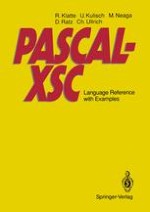This manual describes a PASCAL extension for scientific computation with the short title PASCAL-XSC (PASCAL eXtension for Scientific Computation). The language is the result of a long term effort of members of the Institute for Applied Mathematics of Karlsruhe University and several associated scientists. PASCAL XSC is intended to make the computer more powerful arithmetically than usual. It makes the computer look like a vector processor to the programmer by providing the vector/matrix operations in a natural form with array data types and the usual operator symbols. Programming of algorithms is thus brought considerably closer to the usual mathematical notation. As an additional feature in PASCAL-XSC, all predefined operators for real and complex numbers and intervals, vectors, matrices, and so on, deliver an answer that differs from the exact result by at most one rounding. Numerical mathematics has devised algorithms that deliver highly accurate and automatically verified results by applying mathematical fixed point theorems. That is, these computations carry their own accuracy control. However, their imple mentation requires arithmetic and programming tools that have not been available previously. The development of PASCAL-XSC has been aimed at providing these tools within the PASCAL setting. Work on the subject began during the 1960's with the development of a general theory of computer arithmetic. At first, new algorithms for the realization of the arithmetic operations had to be developed and implemented.
